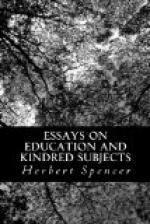This further illustration will, I think, justify the position that something may be achieved by pursuing in other cases this method of psychological inquiry. A complete explanation of the phenomena, requires us to trace out all the consequences of any given state of consciousness; and we cannot do this without studying the effects, bodily and mental, as varying in quantity at each other’s expense. We should probably learn much if we in every case asked—Where is all the nervous energy gone?
[1] Macmillan’s Magazine, March 1860.
[2] For numerous illustrations see essay on “The Origin and Function of Music.”
ON THE ORIGIN AND FUNCTION OF MUSIC[1]
When Carlo, standing, chained to his kennel, sees his master in the distance, a slight motion of the tail indicates his but faint hope that he is about to be let out. A much more decided wagging of the tail, passing by and by into lateral undulations of the body, follows his master’s nearer approach. When hands are laid on his collar, and he knows that he is really to have an outing, his jumping and wriggling are such that it is by no means easy to loose his fastenings. And when he finds himself actually free, his joy expends itself in bounds, in pirouettes, and in scourings hither and thither at the top of his speed. Puss, too, by erecting her tail, and by every time raising her back to meet the caressing hand of her mistress, similarly expresses her gratification by certain muscular actions; as likewise do the parrot by awkward dancing on his perch, and the canary by hopping and fluttering about his cage with unwonted rapidity. Under emotions of an opposite kind, animals equally display muscular excitement. The enraged lion lashes his sides with his tail, knits his brows, protrudes his claws. The cat sets up her back; the dog retracts his upper lip; the horse throws back his ears. And in the struggles of creatures in pain, we see that the like relation holds between excitement of the muscles and excitement of the nerves of sensation.




